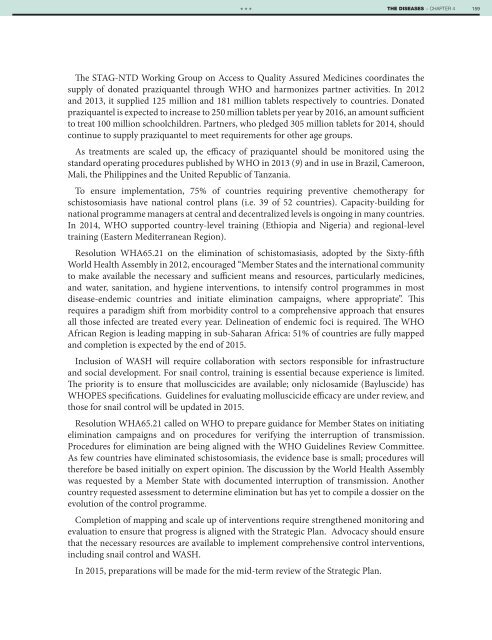1A9bnbK
1A9bnbK
1A9bnbK
Create successful ePaper yourself
Turn your PDF publications into a flip-book with our unique Google optimized e-Paper software.
***<br />
THE DISEASES − CHAPTER 4<br />
159<br />
The STAG-NTD Working Group on Access to Quality Assured Medicines coordinates the<br />
supply of donated praziquantel through WHO and harmonizes partner activities. In 2012<br />
and 2013, it supplied 125 million and 181 million tablets respectively to countries. Donated<br />
praziquantel is expected to increase to 250 million tablets per year by 2016, an amount sufficient<br />
to treat 100 million schoolchildren. Partners, who pledged 305 million tablets for 2014, should<br />
continue to supply praziquantel to meet requirements for other age groups.<br />
As treatments are scaled up, the efficacy of praziquantel should be monitored using the<br />
standard operating procedures published by WHO in 2013 (9) and in use in Brazil, Cameroon,<br />
Mali, the Philippines and the United Republic of Tanzania.<br />
To ensure implementation, 75% of countries requiring preventive chemotherapy for<br />
schistosomiasis have national control plans (i.e. 39 of 52 countries). Capacity-building for<br />
national programme managers at central and decentralized levels is ongoing in many countries.<br />
In 2014, WHO supported country-level training (Ethiopia and Nigeria) and regional-level<br />
training (Eastern Mediterranean Region).<br />
Resolution WHA65.21 on the elimination of schistomasiasis, adopted by the Sixty-fifth<br />
World Health Assembly in 2012, encouraged “Member States and the international community<br />
to make available the necessary and sufficient means and resources, particularly medicines,<br />
and water, sanitation, and hygiene interventions, to intensify control programmes in most<br />
disease-endemic countries and initiate elimination campaigns, where appropriate”. This<br />
requires a paradigm shift from morbidity control to a comprehensive approach that ensures<br />
all those infected are treated every year. Delineation of endemic foci is required. The WHO<br />
African Region is leading mapping in sub-Saharan Africa: 51% of countries are fully mapped<br />
and completion is expected by the end of 2015.<br />
Inclusion of WASH will require collaboration with sectors responsible for infrastructure<br />
and social development. For snail control, training is essential because experience is limited.<br />
The priority is to ensure that molluscicides are available; only niclosamide (Bayluscide) has<br />
WHOPES specifications. Guidelines for evaluating molluscicide efficacy are under review, and<br />
those for snail control will be updated in 2015.<br />
Resolution WHA65.21 called on WHO to prepare guidance for Member States on initiating<br />
elimination campaigns and on procedures for verifying the interruption of transmission.<br />
Procedures for elimination are being aligned with the WHO Guidelines Review Committee.<br />
As few countries have eliminated schistosomiasis, the evidence base is small; procedures will<br />
therefore be based initially on expert opinion. The discussion by the World Health Assembly<br />
was requested by a Member State with documented interruption of transmission. Another<br />
country requested assessment to determine elimination but has yet to compile a dossier on the<br />
evolution of the control programme.<br />
Completion of mapping and scale up of interventions require strengthened monitoring and<br />
evaluation to ensure that progress is aligned with the Strategic Plan. Advocacy should ensure<br />
that the necessary resources are available to implement comprehensive control interventions,<br />
including snail control and WASH.<br />
In 2015, preparations will be made for the mid-term review of the Strategic Plan.


